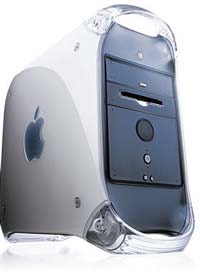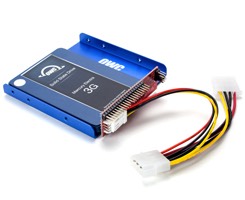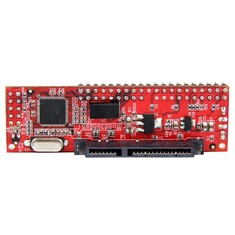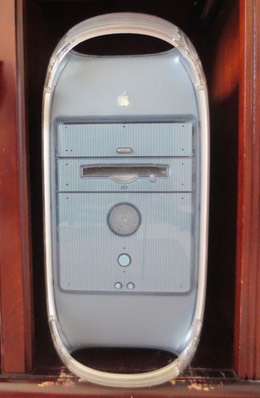
Episode I - Attack of the Hard Drive Clicks
A long time ago in a galaxy far, far away… we bought a Yikes! Power Mac G4. It came out in 1999 and was described as Apple’s first serious pro computer, a supercomputer by the standards of the time. This awesome desktop machine served us well for many years. Using this G4, I designed our websites with Dreamweaver, ran CorelDraw to make gifs for our pages, and used other mundane applications like Microsoft Office X and iTunes.
Alas, this wonder machine was eventually superseded, and it faded into second class status next to our newer toys. However, I’m not one to discard something that still has usefulness, so it continued to perform background work as our web server for Pussicam (our cat website) for a long time, until one day, about five years ago, it produced the hard drive click of death.
I was very busy at work and home at the time. I quickly relocated the cat web site to run somewhere else, and just let the G4 collect dust under my desk, hoping to eventually have time to open it up and see if anything was salvageable.
Fast forward five years: When I was laid off at the end of 2017, I suddenly found I had time to catch up on all of my neglected To Do projects, like recaulking our shower, painting rooms, and figuring out what to do with the large paperweight sitting under my desk.
I pulled out the machine and opened it up. I knew it had two hard drives, but I didn’t remember much else about the system. I figured the main hard drive that booted the machine was dead, and with everything being so old, I didn’t have much chance of resurrecting it. But it was still worth a shot.
I disconnected the G4’s drives from their IDE cables and connected each one in turn to my laptop via a very handy gadget left from a previous hard drive debug effort, the Sabrent USB 2.0 cable to Serial ATA (SATA) and IDE Hard Drive interface (something like this gadget, but an older model). This device allows you to access any hard drive from another computer and is very handy both for debugging faulty drives and for transferring data during a computer migration.
The main drive was still Mr. Clicky, but the second drive worked fine; it’s data was fully visible to my laptop. But that was still no guarantee that I had ever made the second drive bootable. I verified the drive’s jumper settings, put it back into the machine in the first IDE connection, and powered the G4 on.
Two minutes later (it is very slow booting) my old G4 was alive and well. It turns out that many moons ago, we had apparently replaced another dying drive and installed Carbon Copy Cloner to set up the replacement. This backup drive was a fully bootable clone, with higher capacity than the original drive, and worked perfectly.
Not only that, but as I browsed around the drive, I discovered it still held some old photos of my grandmother from her youth and a few original short story and poetry Word documents I had written, data which I forgot to migrate over when we were moving to our newer computers. It was a good day!
Episode II - Revenge of the SSD
Now, in the intervening five years since the G4 had died, I have maintained our websites in various locations. Getting the G4 back up and working opened up the possibility of using it again as our main web server. Why would I do this? Let me tell you a story...
So, as I explained in Episode I, the G4 had been running our cat website Pussicam for years. But the G4 was running Apache 1.3, and I never figured out how to make it run more than one website, so I’d been serving our family website Oreganet out of Dropbox during the same time period.
Dropbox worked great because it was basically free for low level users like us, and it was reliable. We’re just running personal websites for family and fun, so it wasn’t worth paying for a web host provider.
After the G4 died, I just moved Pussicam to run out of Dropbox, right alongside Oreganet. The URLs were a little funky, but it was still free and easy and reliable.
Unfortunately, all good things must come to an end, especially when they’re free. Dropbox announced that as of October 3, 2016 they were discontinuing the ability to render HTML content in-browser.
So I had to migrate our home websites one more time… and this time I moved them to my current computer, a Macbook Pro. Macs are easily run as web servers, so this was pretty trivial. The URLs were still kind of funky, until I figured out how to set up virtual hosts. But there was one big problem.
My laptop has a habit of either going to sleep or losing its internet connection when not in use. This routinely happens when I forget to plug it in. I have the energy saver set to keep the computer on when it’s AC powered, but sometimes the energy saver forgets the stay-on setting and reverts to power saving shutdown after fifteen minutes. So if you stopped by Oreganet at night or when I was on vacation, there was a pretty good chance that the website wouldn’t be alive. Not the most reliable!
But the G4 doesn’t go to sleep. It’s a perfect web server. Except that it was down to a single very old hard drive and running Apache 1.3. More on Apache in the next episode.

The first order of business was to get a new backup drive installed. I shopped over at Other World Computing and found the perfect solution for about $100: the 120GB OWC Mercury Pro Legacy 3.5-inch IDE/ATA Solid-State Drive Kit. This solid state drive is likely to be much more reliable than the old style spinning hard drive it was replacing. It comes with an IDE/SATA converter board, cable, and metal sled for mounting. And it’s compatible with my very old G4!
When it arrived, I prepared to install it in the machine. I thought I would make use of the metal sled to mount it on top of the primary drive. I plugged the SSD into the converter board SATA (the black header), noting that the design engineer picked an oscillator that was slightly too tall (poor clearance with the side of the drive) — should have used low profile! It barely mated. I plugged in the power cable and mated the G4’s IDE cable to the converter board (header, other side). Mounting options were limited, but I found one screw that seemed to line up just right on the left side and fixed the sled in place against the other drive’s metal carrier. Then I closed the bay door and heard a small and slightly worrisome click. I booted the G4, but there was no second drive visible.
Powering off, I opened up the unit and found, to my dismay, that the fit with the SSD and the IDE cables and the converter was just a little too tight, and the SATA header housing on the converter board had dislodged and cracked off the PCB, bending the pins. The pressure from the short IDE cables caused too much torque in the tight space when I closed the bay door. The SSD itself appeared to be fine, thankfully. To be sure, I hooked up the Sabrent cable and checked it with my laptop, and it showed up. I contacted OWC for help. The damage wasn’t really their fault, so I knew I’d have to replace the broken board myself. They emailed me the part number to order a replacement board, but I actually found it cheaper elsewhere (about $15). So at least my mechanical mistake wasn’t too expensive.
The new converter board arrived two days later and I went back through the process of installing the SSD. This time I did NOT mount the sled but left it free to slide on top of the other drive. I closed up the bay very slowly and carefully, feeling for any undue tension, and then booted up. Tada! The SSD was recognized.
I ran Carbon Copy Cloner to make a fully bootable backup drive to keep the G4 happy and healthy. With my drives working great, it was time to get back to the Apache upgrade.
Episode III - The Software Strikes Back
I knew that if I was going to make the G4 our web server again, I really wanted it to run Apache 2. Oh, I’m sure 1.3 would have worked, but I really liked how my laptop, running Apache 2.4, served our assorted family web pages. I’ve been thinking of dabbling with PHP as well, and I wanted the latest tools. And it was nice to have a fun technical challenge to keep my engineering brain working while I’m job hunting. So why not?!
Oh, and since I’d just cloned my hard drive onto the SSD, I knew I had a clean backup, just in case I really messed up and needed to do a full restore. It’s good to be prepared.
I confirmed that it was indeed possible to upgrade Apache on a mac running 10.4.11 Tiger. It didn’t look too hard, judging by this article. You know, kind of like when you buy some DIY furniture and you sort of skim the instructions and it looks easy?
I meandered over to Apache, downloaded 2.4, checked signatures and hash, and discovered somewhere in my readings that I’d need a compiler (GCC). Yeah, I probably should have realized I was going to need a compiler.
It is worth noting here that I am a hardware engineer. I don't deal with software that often. I play with circuit boards & schematics, oscilloscopes & logic analyzers. I sometimes write verilog to run a baseboard FPGA. I provide explanatory spreadsheets and detailed design notes to my fellow software engineers who then generate the code to run my boards. At work, on those rare occasions when I’ve installed custom software on a server, I’ve had expert help. At home, I’ve mostly just installed ordinary GUI-based applications using Apple disk image “dmg” installers. So I am not well versed in running “./configure, make, make install." I proceeded with extreme caution. I read a lot online to try to understand what I was doing.
I found out that for GCC on the Mac, I needed Xcode. This would be easy if I were installing it on my laptop, but it was a much different challenge on my very old G4. I’d never needed Xcode before, and a much older legacy version was required for my 19 year old mac. (Go ahead and laugh.) I hunted online for tips for an hour and searched around Apple’s website without success, continually encountering stale links. I then found out that Xcode originally came with the OS installation disc, so I searched our shelves, dusted off the box, and installed 2.0, hoping it would be good enough. Only Xcode wouldn’t install while I had low disc space (~10Gb). The installation notes indicated that you need adequate space for the final step of optimizing performance. I eventually cleared about 25Gb by deleting some old podcast files to allow installation to work. I set it going and waited. And waited. The final installation took all night, but in the morning I found it was a success.
Feeling a bit more hopeful, I tried to install Apache 2.4, which promptly gave me an error that I needed PCRE.
It was at this point that I realized I probably should have read the Apache installation page a bit more closely.
Not only did I need PCRE (the Perl-Compatible Regular Expressions Library), I also needed APR (Apache Portable Runtime (APR) project) and APR-Util. I made myself a checklist to ensure I didn’t miss anything else.
The Apache Portable Runtime (APR) project was the only thing that installed without issue.
The APR-util was another matter. APR-util gave me errors about missing expat.h, which then led me down the rabbit hole of trying to find something called yum, a package management utility. I found out that yum is for Linux but won’t work on OS X. According to this article, I’d need either Homebrew or Macports. Homebrew, billed as the “missing package manager for macOS”, requires OS X 10.10 or higher. So instead, I installed Macports, only to realize I still really needed to be able to run “brew" from Homebrew. So I went back to Homebrew and found that there was an experimental fork called Tigerbrew that would run on 10.4.
Unfortunately, the ruby installer script failed to run, so I went back to try installing PCRE. Only PCRE was obsolete; I had to install PCRE2. That took quite a bit of fiddling but I eventually got it working.
I then came back to where I’d gotten stuck before. Installing “expat" needed “libtool” and “libtoolize”. Some online tips suggested using "apt-get", which bounced me back to Homebrew and Macports. I tried using Macports to attempt to install “libtool", but it failed because my Xcode wasn’t version 2.5.
(And yes, my head was also spinning. I read a lot of stackoverflow.com webpages trying to figure all that out.)
I was thoroughly stuck. I went back to Apple’s developer website to try and find 2.5 again, but this time I followed a different path in and finally got hold of Xcode 2.5. At last! And it installed successfully.
At this point, I went on vacation. Which was probably a good thing.
Episode IV: The Voyage Home(?)
Three weeks later, after a very nice vacation in St. Augustine, Florida, as well as painting two rooms in our house, I returned to my pet technical project.
I gave up on the expat and libtool errors and revisited Tigerbrew. It was clear I really needed Tigerbrew.
Unfortunately, the ruby script that was supposed to install Tigerbrew wouldn’t run. (I didn’t even know what ruby was when I started this process, but at least it was already installed on the G4.) I figured out how to manually install Tigerbrew by deciphering the install script’s assorted commands. It involved creating folders, moving files from the unzipped Tigerbrew tar, exporting a PATH variable, and setting permissions and file/folder ownership correctly. Thankfully, no compiling was required. I then had additional issues to repair after running “brew doctor” (a handy checker!). Tigerbrew’s installation also included installing curl and git (at least I knew git from work). It took me two days to work through several issues, but eventually I reached the point at which I could actually run the “brew" command.
In hindsight, I suspect that if I’d successfully installed Tigerbrew much earlier in this process, I probably could have installed everything a lot more gracefully.
I finally installed apr-util without errors. But Apache 2.4 still wouldn’t install due to some kind of issue where it kept looking for PCRE instead of PCRE2 (I tried a linking fix, but that didn’t work). I used brew to fix the issue (by basically installing PCRE, “brew install PCRE"), and then finally, after so many challenges, I successfully installed Apache 2.4.
Of course, my Apache upgrade saga wasn’t quite over. For the easiest part, I transferred our websites over from the laptop to the G4 and fixed up virtual hosts on the new machine. But no matter what I tried, the G4 kept serving the files from the old WebServer folder, ignoring my virtual hosts in the new Sites folder. After all that effort, I couldn’t believe I was going to be thwarted by this last issue.
After a long break for dinner, I fiddled with the StartupItems for Apache and learned how to create a new launch daemon for Apache 2.
About 10 o’clock at night, after fixing and fiddling with startup and virtual host settings all day, our websites finally loaded properly from the Sites folder, and Apache 2.4 was running from boot. At last, success!
And amazingly, I didn’t break my old computer. (I hope!)
So, if you are reading this post around April 2018, you are being served site pages by our G4 bought in 1999! Oreganet now runs 24/7!
Meet our Yikes! G4 (circa 1999). It runs our web server, which hosts Oreganet.
Disclaimer: Neither Jedi nor humpbacked whales were harmed in the updating of this G4. However, a few Star Wars fans may have been mildly annoyed by the Star Trek switchover at the end.
Episode I References:
Yikes! Power Mac G4 History (including G4 image credit)
http://www.apple-history.com/g4pci
https://en.wikipedia.org/wiki/Power_Mac_G4
Hard drive click of death:
http://harddriveclicking.net/hard-drive-clicking/click-of-death
Sabrent USB 3.0 TO SATA/IDE 2.5/3.5/5.25-INCH Hard Drive Converter With Power Supply & LED Activity Lights [4TB Support] (USB-DSC9):
https://www.amazon.com/gp/product/B00DQJME7Y/ref=s9_acsd_hps_bw_c_x_7_w
Hard Drive Jumper Settings - Use Cable Select (Default):
https://support.wdc.com/knowledgebase/answer.aspx?ID=981
Episode II References:
Dropbox Drops HTML Rendering:
https://www.dropbox.com/help/files-folders/public-folder
120GB SSD Kit from OWC (including SSD image credit):
https://eshop.macsales.com/item/OWC/SSDMXLE120/
IDE/SATA converter board (including image credit):
Episode III References:
Installing Apache 2 on OS X 10.4:
http://hints.macworld.com/article.php?story=20051214031718251
Apache HTTP Server, version 2.4 info:
Apache Portable Runtime (APR) project:
Xcode history:
https://en.wikipedia.org/wiki/Xcode
Perl Compatible Regular Expressions (PCRE):
Expat, a stream-oriented XML parser library written in C:
Yum, package management utility for Linux:
https://en.wikipedia.org/wiki/Yum_(software)
Info about the equivalent to apt-get or yum on Mac OS X:
https://unix.stackexchange.com/questions/80711/how-to-install-apt-get-or-yum-on-mac-os-x
Homebrew:
Macports:
Tigerbrew:
https://github.com/mistydemeo/tigerbrew
Libtool, a generic library support script:
https://www.gnu.org/software/libtool/
Chasing an error for “libtoolize”:
https://unix.stackexchange.com/questions/118550/autoreconf-fails-with-cant-exec-libtoolize
Apt-get, advanced packaging tool:
https://en.wikipedia.org/wiki/APT_(Debian)
The very awesome StackOverflow pages where I found countless help and tips:
Episode IV References:
Ruby, a programming language, good for scripting:
Curl, a cool tool for transferring data with URLs:
Git, a distributed version control system for managing code projects. Seriously, if you are creating code, from C++ to verilog (yes, this also applies to hardware engineers!), you need Git!
Everyone, remember where we parked. You didn’t really think I’d finish with a Star Wars reference, did you?
https://www.youtube.com/watch?v=Yh8u59A54So


